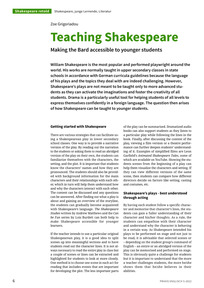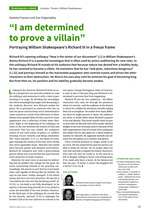Teaching Shakespeare Making the Bard accessible to younger students
Bei Bezahlung über Paypal und Kreditkarte können keine Sonderkonditionen gewährt werden.
Melden Sie sich dafür bitte mit Ihrem Kundenkonto an.
Frische Ideen für den Englischunterricht!
Ihr Wegweiser zu den wichtigsten Seiten von PRAXIS ENGLISCH:
Mehr zur Zeitschrift| Produktnummer | OD200041015090 |
| Schulform | Realschule, Realschule plus, Sekundarschule, Mittelschule, Regelschule, Regionale Schule, Oberschule, Integrierte Gesamtschule, Gymnasium, Sekundarstufe II, Berufsgrundbildungsjahr, Berufsfachschule, 2-jährige |
| Schulfach | Englisch |
| Klassenstufe | 6. Schuljahr bis 13. Schuljahr |
| Seiten | 3 |
| Erschienen am | 01.10.2022 |
| Dateigröße | 182,7 kB |
| Dateiformat | PDF-Dokument |
| Autoren/ | Zoe Grigoriadou |
| Schlagworte | Literatur, Shakespeare, junge Lernende |
William Shakespeare is the most popular and performed playwright around the world. His works are normally taught in upper secondary classes in state schools in accordance with German curricula guidelines because the language of his plays and the topics they deal with are indeed challenging. However, Shakespeare’s plays are not meant to be taught only to more advanced students as they can activate the imaginations and foster the creativity of all students. Drama is a particularly useful tool for helping students of all levels to express themselves confidently in a foreign language. The question then arises of how Shakespeare can be taught to younger students.














